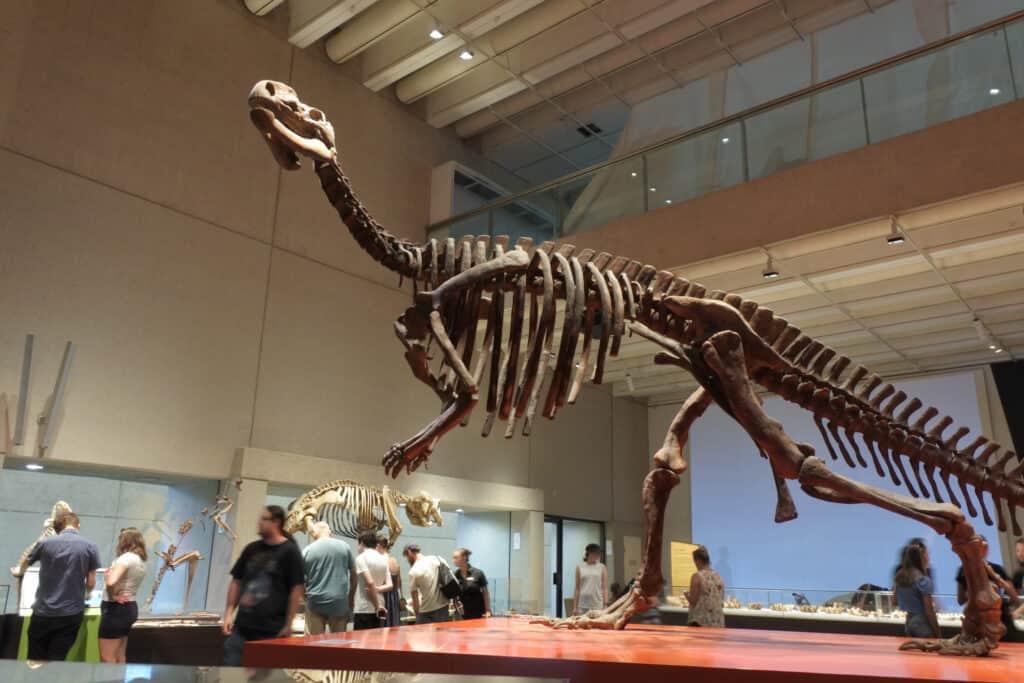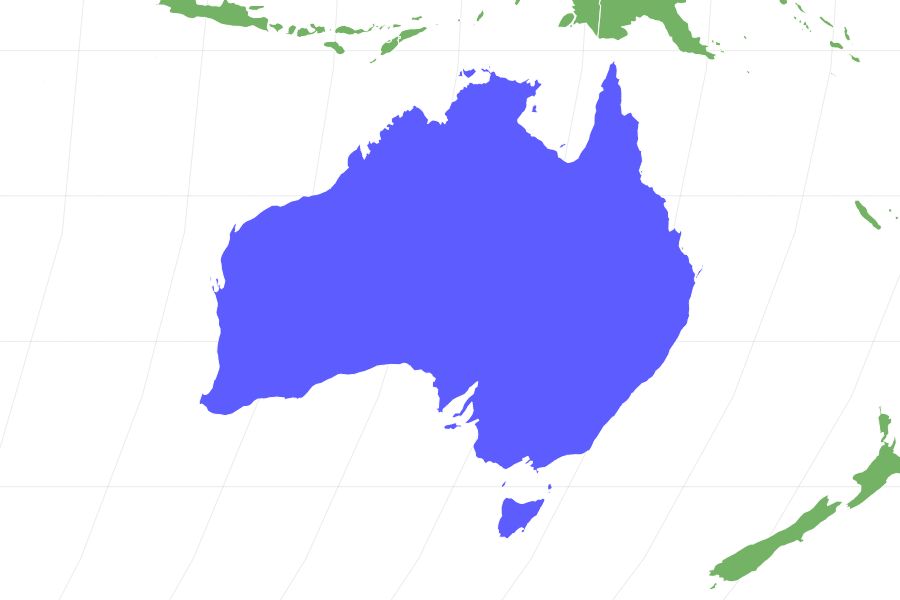Muttaburrasaurus
They stood about 26 feet tall and weighed more than 3 tons, as heavy as today's African forest elephants.
Advertisement
Muttaburrasaurus Scientific Classification
- Kingdom
- Animalia
Muttaburrasaurus Facts
- Group Behavior
- Herd
- Herds
- Fun Fact
- They stood about 26 feet tall and weighed more than 3 tons, as heavy as today's African forest elephants.
- Biggest Threat
- Theropod dinosaurs
- Diet for this Fish
- Omnivore
- Favorite Food
- Its diet included ferns, cycads, club-mosses and conifers.
- Type
- Dinosaur
View all of the Muttaburrasaurus images!
Description and Size
Muttaburrasaurus (Muttaburrasaurus langdoni) was an iguanodontian ornithopod dinosaur that lived between 113 million and 100 million years ago during the Early Cretaceous period in northeastern Australia along the edge of the prehistoric inland Eromanga Sea. Being from the order Ornithischia, Muttaburrasaurus had a pelvic structure like modern-day birds. The herbivore measured about 7.5 feet tall and 26 feet long. It weighed about 3.1 tons.
This prehistoric animal is named for the region in which it was discovered, Muttaburra, Queensland, Australia. The name Muttaburrasaurus means, “Muttaburra lizard.” The second half of the creature’s binomial name, Muttaburrasaurus langdoni, comes from the surname of the man who first discovered the fossilized specimen. That man, Doug Langdon, worked with livestock and uncovered the partial skeleton in 1963.
Scientists are not yet sure whether Muttaburrasaurus moved about on its two hind feet or all four of its legs. But it is known that it had long, broad feet with four toes and no thumb spikes. Muttaburrasaurus’ femurs were about 40 inches long.
The dinosaur’s skull is flat, broad and triangle-shaped from the top. It features a big hollow, an upward-pointing snout that resembles a parrot’s beak, and is believed to have made a unique trumpeting sound.
Measurements of the Muttaburrasaurus include:
- Height – 7.5 feet
- Length – 26 feet
- Weight – 3.1 tons (6,200 pounds)
- Femur length – 40 inches

4 Cool Facts About Muttaburrasaurus
- The three middle foot joints of the Muttaburrasaurus’ forelimbs are fused together to form a hoof-like structure that could hold its weight.
- These dinosaurs reproduced by laying eggs.
- They stood about 26 feet tall and weighed more than 3 tons, as heavy as today’s African forest elephants.
- Scientists suspect the Muttaburrasaurus lived in herds.
- Paleontologists have unearthed 3 specimens in different areas of Australia, as well as many of the species’ teeth.
Diet – What Did Muttaburrasaurus Eat?
What did Muttaburrasaurus eat? As an herbivore, the dinosaur ate leafy greens from understory vegetation, meaning the layer of leafy growth under a forest’s canopy. Its diet included ferns, cycads, club-mosses and conifers. The animal stood on all four legs to feed, but raised up onto its back legs for swift running and to reach higher vegetation with its long neck. We know this because of the dinosaur’s bird-like skeletal structure and larger back legs.
Muttaburrasaurus had strong jaws and a tough keratin-covered front beak. There were no teeth in the front of its mouth, but it had shearing back teeth that indicate a chewing motion. Scientists originally thought the dinosaur was omnivorous. But experts later decided these shearing teeth were not for meat, but extremely tough vegetation like today’s palm trees and evergreens.
Habitat – When and Where It Lived
Muttaburrasaurus was discovered in Queensland. This is the northeastern region of Australia. An almost complete skeleton of bones was uncovered in the Mackunda Formation that dates to the Late Cretaceous period. This particular species lived from about 113 million to 100 million years ago.
The region where Muttaburrasaurus was found was a marine environment on the edge of the ocean. During its lifetime, Australia was part of the Antarctic Circle. Its temperatures ranged from below freezing on dark winter days to warm seasons. In fact, it was one of the coldest places on the planet at that time. This indicates that Muttaburrasaurus and other species living on the continent were hardy and potentially warm-blooded.
Another specimen of Muttaburrasaurus was later found in central Queensland. A third was uncovered in New South Wales.

Muttaburrasaurus was a large, plant-eating ornithopod from the Early Cretaceous period.
©ChameleonsEye/Shutterstock.com
Threats and Predators
So far, it is only known that Muttaburrasaurus was probably hunted by theropod dinosaurs similar to the Australovenator. But Australovenator lived during a more recent era by about 10 million years. This timing means it was likely not the precise threat to Muttaburrasaurus.
Much is still being learned about Australia’s dinosaur species as this region did not have the glacial activity of geographies like North America, where fossils are naturally lifted from lower levels of the earth. This means that fewer fossil specimens are discovered in Australia and less is known about the ones discovered there.
Discoveries and Fossils – Where It Was Found
Doug Langdon, a grazier in Australia, discovered the first Muttaburrasaurus specimen in 1963. His find led to a skeleton that was 60% complete. It was found in marine rocks in what was likely a shallow sea during the dinosaur’s time. It is believed the creature’s body washed out to sea where it drifted for a period of time, bloated and then wedged in the rocks. But the animal did not live in the water.
The dinosaur is named for Muttaburra, the town and region in Queensland where it was discovered. It was specifically found in the Mackunda Formation, a fossil site dating to the Cenomanian stage of the Late Cretaceous era, 100 million years ago. Teeth from Muttaburrasaurus were found farther north and south in Queensland, as well as in New South Wales. Fragments of Muttaburrasaurus skeletons have been found since the first one.
If you want to see the reconstructed Muttaburrasaurus skeleton on display, you can visit the Queensland Museum, Flinders Discovery Centre and National Dinosaur Museum of Australia.
Extinction – When Did It Die Out?
Muttaburrasaurus is believed to have gone extinct about 100 million years ago, at the end of the Early Cretaceous period. There are multiple theories about why this could have happened. Scientists believe disease, climate changes, lost reproductive ability because of environmental changes and egg-eating mammals could have led to the end of multiple species at the same time as Muttaburrasaurus. They also believe there could have been a collision of a large asteroid or comet with Earth that caused extinction. There are no definite answers about this species yet.
Similar Animals to the Muttaburrasaurus
Similar animals to Muttaburrasaurus include:
- Tenontosaurus – A North American medium- to large-sized ornithopod like Muttaburrasaurus and dating to the same era. This herbivore dinosaur looked very much like Muttaburrasaurus, but did not have the parrot-like beak.
- Atlascopcosaurus – A smaller Australian ornithopod about 1/4 to 1/2 the length of Muttaburrasaurus and only weighing about 275lbs. It was also an herbivore and had many of the same body characteristics as the bigger dinosaur.
- Albertadromeus syntarsus – A tiny ornithopod discovered in Canada that, like Muttaburrasaurus, could flee from predators by running only on its two back legs. It had many of the same characteristics as its bigger counterpart from Australia. But it was only the size of a modern turkey and lived in the Late Cretaceous period around 77 million years ago, about 25 million years after Muttaburrasaurus.
Muttaburrasaurus FAQs (Frequently Asked Questions)
When did Muttaburrasaurus live?
Although expert timelines can vary slightly, it is believed that the Muttaburrasaurus lived from 113 million years ago to 100 million years ago. This was during the Early Cretaceous period. Some scientific resources date the dinosaur to as recently as 93 million years ago, during the Late Cretaceous period.
How big was Muttaburrasaurus?
Muttaburrasaurus was a medium-sized herbivore in its time, similar in size to the African forest elephants of today. These dinosaurs measured about 7.5 feet tall and 26 feet from nose to tail tip. They weighed about 3 tons, 6200 pounds.
Where does the name "Muttaburrasaurus" come from?
The name Muttaburrasaurus comes from the region where this dinosaur fossil was first discovered, Muttaburra in Queensland, Australia. Saurus is the ancient Greek term for “lizard” or “reptile.”
Where did the Muttaburrasaurus live?
The Muttaburrasaurus lived in central and northern Queensland in the northeastern part of Australia. Fossilized remains also indicate the dinosaur once lived in New South Wales during its time of the Early Cretaceous period, 100 million years ago. It specifically lived on the forested shores of the inland Eromanga Sea.
What did Muttaburrasaurus look like?
Like other ornithopods, Muttaburrasaurus had a bird-like pelvis. This skeletal structure gave it a body shape similar to a modern-day turkey. It had large back legs and smaller front limbs. Unlike many ornithopods, it is believed Muttaburrasaurus walked on all four feet. But scientists theorize it ran on just the back two legs for speed. Muttaburrasaurus was about 26 feet long from its parrot-like snout to its long, stiff tail tip. It had a slightly long neck for feeding from tall plants and trees while standing semi-erect.
What did Muttaburrasaurus eat?
Muttaburrasaurus was an herbivore like other ornithopods of its time. Because of the shape of its back teeth, scientists once believed it was an omnivore, occasionally eating meat. But in recent years, this opinion has changed. Instead, experts say the dinosaur’s shredding back teeth were likely used to tear into tough plants like conifers and cycads, not meat. It also enjoyed eating ferns and club-mosses. To help it pull plants apart and into its mouth, Muttaburrasaurus had a parrot-like beak snout covered in keratin, without any front teeth.
Where can I see a Muttaburrasaurus?
Because Muttaburrasaurus once lived in Australia, the discovered fossils all came from that continent. Reconstructed specimens are on display in the Queensland Museum, Flinders Discovery Centre and National Dinosaur Museum of Australia. You can also watch these dinosaurs in action in the 5th episode of BBC TV’s Walking with Dinosaurs, “Spirits of the Ice Forests.”
Thank you for reading! Have some feedback for us? Contact the AZ Animals editorial team.
Sources
- Wikipedia, Available here: https://en.wikipedia.org/wiki/Muttaburrasaurus
- Queensland Museum, Available here: https://www.qm.qld.gov.au/Explore/Find+out+about/Dinosaurs+and+Ancient+Life+of+Queensland/Dinosaurs/Eromanga+giants/Muttaburrasaurus
- Jurrasic World, Available here: https://jurassicworld-evolution.fandom.com/wiki/Muttaburrasaurus
- Prehistoric Wildlife, Available here: http://www.prehistoric-wildlife.com/species/m/muttaburrasaurus.html
- Dinosaur Pictures, Available here: https://dinosaurpictures.org/Muttaburrasaurus-pictures
- Washington Museum, Available here: https://museum.wa.gov.au/explore/dinosaur-discovery/muttaburrasaurus
- Mindat, Available here: https://www.mindat.org/taxon-4823237.html

















